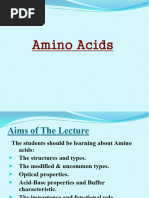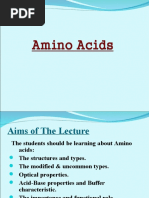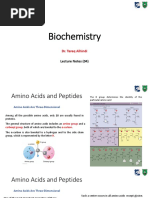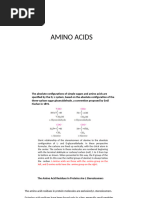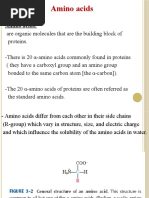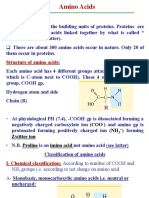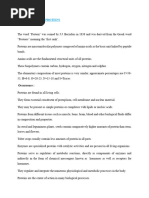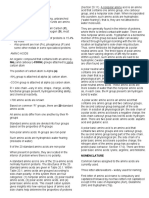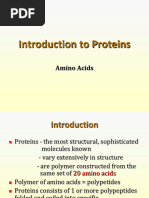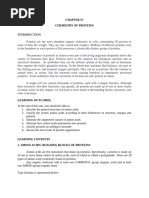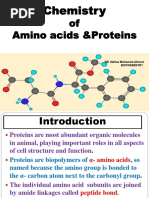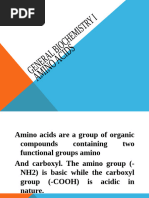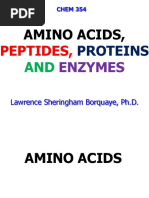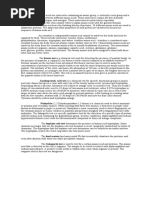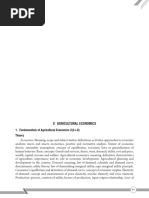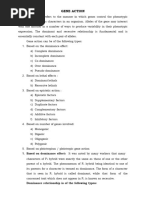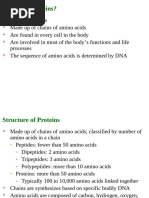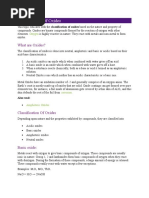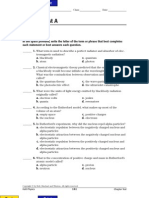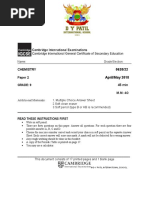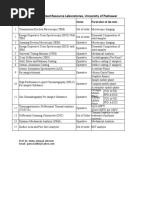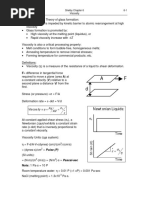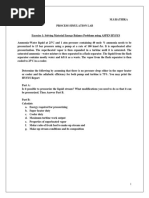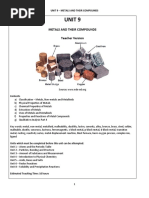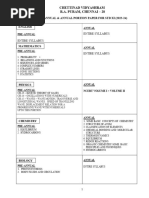0 ratings0% found this document useful (0 votes)
1 viewss15 Miller Chap 3a Lecture
s15 Miller Chap 3a Lecture
Uploaded by
Pranav Tripathi, Ph.D.Copyright:
© All Rights Reserved
Available Formats
Download as PPT, PDF, TXT or read online from Scribd
s15 Miller Chap 3a Lecture
s15 Miller Chap 3a Lecture
Uploaded by
Pranav Tripathi, Ph.D.0 ratings0% found this document useful (0 votes)
1 views27 pagesCopyright
© © All Rights Reserved
Available Formats
PPT, PDF, TXT or read online from Scribd
Share this document
Did you find this document useful?
Is this content inappropriate?
Copyright:
© All Rights Reserved
Available Formats
Download as PPT, PDF, TXT or read online from Scribd
Download as ppt, pdf, or txt
0 ratings0% found this document useful (0 votes)
1 views27 pagess15 Miller Chap 3a Lecture
s15 Miller Chap 3a Lecture
Uploaded by
Pranav Tripathi, Ph.D.Copyright:
© All Rights Reserved
Available Formats
Download as PPT, PDF, TXT or read online from Scribd
Download as ppt, pdf, or txt
You are on page 1of 27
Chap.
3A Amino Acids, Peptides, and
Proteins
Topics
• Amino acids
• Peptides and proteins
• Working with proteins
• The structure of
proteins:
primary structure
Fig. 3-6. Absorption of
ultraviolet light by aromatic
amino acids.
Introduction to Proteins
Proteins mediate nearly every process that takes place
inside a cell. They are the most abundant biological
macromolecules in cells. All proteins, regardless of
organism, are composed of the same set of 20 amino
acids that are incorporated into them during translation.
Due to the nearly limitless variety in the sequences of
amino acids in proteins, nearly all imaginable functions
can be encoded in proteins (Fig. 3-1).
Common Features of Amino Acids
There are 20 "standard" amino acids
that are specified by the genetic code
and polymerized into proteins by
ribosomal translation. All amino acids
contain an carbon to which typically 4
different substituent groups are
attached (Fig. 3-2). These groups are
the -amino group, the -carboxyl
group, hydrogen, and the variable R
group (side-chain). (Note that in
glycine, the R group consists of another
hydrogen atom. In the other 19 amino
acids the carbon is a chiral center.)
The -amino and -carboxyl groups are
charged at neutral pH. There are two
possible configurations for these four
substituents--the "D" and "L"
stereoisomers, which are mirror images
of each other (enantiomers) (Fig. 3-3).
The standard amino acids have the L-
configuration. Amino acids are classified
based on the characteristics of their R
groups. The chemical properties of the
standard 20 amino acids are
Numbering of Carbons in Amino Acids
The conventions for labeling the carbon atoms in amino
acids is illustrated using lysine in the figure. The
carbon is always carbon-2 of the amino acid. The -
carboxyl group is always carbon-1
D,L Classification System for Amino
Acid Configurations
The D, L system is used to specify the absolute
configuration of substituent groups about chiral carbons
in amino acids and monosaccharides. In this system,
amino acids are specified as D or L based on comparison
of their configurations to the reference compounds, D-
and L-glyceraldehyde (Fig. 3-4). Note that not all amino
acids actually are levorotatory. Thus D and L designate
only the configurations of the substituent groups and
not the optical properties of the amino acid.
Classification of Amino Acids by R
Group
Amino acids are collected into different categories
based on similarities in the properties of their R
groups. One such classification scheme (Fig. 3-5)
relies heavily on the polarity of the R groups. Note
that some amino acids such as glycine, histidine, and
cysteine do not fit perfectly into any one group. Thus,
their assignments to a particular group are somewhat
subjective rather than based on absolute
characteristics. The textbook places the amino acids
into five categories based on the properties of their R
groups--nonpolar, aliphatic; aromatic; polar,
uncharged; positively charged; and negatively
charged (next slides).
Nonpolar, Aliphatic Amino Acids
The amino acids in this group lack polar functional
groups in their side chains. Due to the hydrophobicity of
their R groups, they often cluster together within the
interior of proteins, stabilizing protein structure via
hydrophobic interactions. The preferences of several of
these amino acids for regions of protein secondary
structure are discussed in Chap. 4.
Aromatic Amino Acids
The side-chains of the aromatic amino acids,
phenylalanine, tyrosine, and tryptophan, overall are
very hydrophobic. The R group of tyrosine also
contains a polar hydroxyl group that can participate in
H bonding interactions. The R groups of tyrosine, and
particularly tryptophan, absorb ultraviolet light at a
maximum of 280 nm wavelength (Fig. 3-6). Light
absorption by these amino acids is exploited in
detecting and quantifying proteins in the laboratory
using the technique of absorbance spectrometry.
Polar, Uncharged Amino Acids
The R groups of the polar,
uncharged amino acids all
contain polar functional groups
that can hydrogen bond with
water. Serine and threonine
contain hydroxyl groups,
asparagine and glutamine
contain amide groups, and
cysteine contains a sulfhydryl
group, albeit whose polarity is
quite weak. Asparagine and
glutamine are the amide forms
of the two negatively charged
amino acids aspartate and
glutamate. The sulfhydryl group
of the cysteine side chain is a
weak acid (pKa = 8.2). The
cysteine side chain therefore is
mostly uncharged at neutral pH.
Cysteine and Disulfide Bonds
The thiol groups of two cysteine residues are readily
oxidized to form a covalently linked dimeric amino acid
known as cystine. In cystine, the two cysteines are
joined by a disulfide bond (Fig. 3-7). The disulfide-
linked cystine residue is strongly hydrophobic. In
proteins, disulfide bonds form covalent links between
different parts of a polypeptide chain, or between two
different polypeptide chains.
Positively Charged Amino Acids
The most hydrophilic R groups are those that are either
positively or negatively charged. The side-chains of
lysine and arginine are fully positively charged at
neutral pH. In lysine, a primary amino group is attached
to the carbon of the side-chain. In arginine, the
guanidinium group of the side-chain is postively
charged. The histidine R group contains an aromatic
imidazole group that is partially positively charged at
neutral pH (Refer to Worked Example 2-5). Histidine
residues function in many enzyme-catalyzed reactions
as proton donors and/or acceptors.
Negatively Charged Amino Acids
The R groups of aspartate and glutamate contain
carboxyl groups that are fully negatively charged at
neutral pH (pKRs of 3.65 and 4.25, respectively, Table 3-
1). In aspartate, the carboxyl group is attached to the ß
carbon of the amino acid backbone. In glutamate, the
carboxyl group is attached to the carbon.
Intro. to Amino Acid Ionization (I)
The -carboxyl and -amino groups of all amino acids,
along with the ionizable R groups of 7 amino acids,
function as weak acids and bases in aqueous solutions
(Table 3-1). The pKas of these functional groups depend
on the chemical properties of the groups themselves and
range between 1.8-2.4 for the -carboxyl groups, and 8.8-
11.0 for -amino groups. When a simple amino acid such
as alanine, which lacks an ionizable functional group in
its side-chain, is dissolved in water at neutral pH, its -
carboxyl group is negatively charged, and its -amino
group is positively charged. Such dipolar ions (total
charge equals 0) are called zwitterions. Substances
having this dual (acid-base) nature are amphoteric and
are often called ampholytes. The ionization behavior of
the -carboxyl and -amino groups of a simple amino acid
such as alanine are shown in the diagram below.
Intro. to Amino Acid Ionization (II)
The nonionic and zwitterionic forms of a simple amino
acid such as alanine are shown in Fig. 3-9. The
zwitterionic form predominates at neutral pH. The
nonionic form does not occur in significant amounts in
aqueous solution at any pH. A zwitterion can act as
either an acid (proton donor) or a base (proton
acceptor).
Titration of Simple Amino Acids
The titration curves of simple amino
acids such as glycine (Fig. 3-10) that
have non-dissociable R groups, have
two plateaus, which correspond to
the dissociation and titration of the
-carboxyl group (pK1, left) and the
-amino group (pK2, right). As shown
above the curve, the predominant
ionic species in solution at low pH is
the fully protonated form, +H3N-CH2-
COOH (net charge = +1), In between
the two plateaus, the zwitterionic
form, +H3N-CH2-COO- (net charge = 0)
predominates. At the end of the
titration, the fully dissociated
species H2N-CH2-COO- (net charge -1)
predominates. The curve shows that
above
glycinepK 1 and
has twopK 2. The Henderson-Hasselbalch
regions of buffering equation
can
powerbe centered
used to calculate
±1 pH unitthe amounts of the conjugate
acid and conjugate base species in solution at any pH.
Lastly, the pH at which the zwitterionic (0-charged)
species of glycine predominates (one equivalent of OH-
added) is called the isoelectric point or isoelectric pH.
The isoelectric pH is exactly halfway between the two
Chemical Environment and the pKa
The pKas of the -carboxyl groups of all amino acids are
lower than the pKas of the carboxyl groups in methyl-
substituted carboxylic acids such as acetic acid (Fig. 3-11).
This is due to the local chemical environment of the -
carboxyl groups in amino acids. Namely, placement near
the -amino group, which is positively charged, makes the
-carboxyl groups of amino acids more acidic than the
carboxyl group of acetic acid. Similarly, the chemical
environment near -amino groups makes them more acidic
than the amino groups of a methyl-substituted amino
compounds such as methylamine. In this case the electron
withdrawing properties of the oxygens on the -carboxyl
groups of amino acids make the -amino groups hold onto
their protons less tightly than in other environments.
Titration of Glutamate
The acidic amino acid,
glutamate, has a second
carboxyl group present in its
side-chain. Thus the titration
curve for glutamate (and
aspartate) has three plateaus,
each one corresponding to the
dissociation of a proton from
the amino acid (Fig. 3-12a).
Since the R group carboxyl
group has a pKR between that
of the pK1 and pK2, the second
plateau corresponds to the
titration of this group. Based
on inspection of the ionic forms
in solution (top) it is clear that
the zwitterionic form of
glutamate occurs at a pH
midway between that of pK1
Titration of Histidine
Histidine has an imidazole R
group that contains a
dissociable proton with a pKR
of 6.0. Thus the titration
curve for histidine also has
three plateaus (Fig. 3-12b).
For histidine, the 0-charged
zwitterionic species occurs in
solution at a pH midway
between pKR and pK2 (pI =
7.59). Because the histidine
pKR is near neutrality, the R
group of histidine plays a
role in buffering the pH of
solutions containing proteins.
Peptide Bonds
Peptide bonds are amide linkages that join amino acids
in oligopeptides, polypeptides, and proteins. Peptide
bonds are formed by condensation reactions in which the
elements of water are removed (dehydration) from the
reacting -amino and -carboxyl groups that come
together to form the bond (Fig. 3-13). Note that peptide
bonds in proteins are formed in vivo via a different
mechanism than the one shown in the diagram. The term
oligopeptide refers to polymers with relatively few
amino acid residues. The term polypeptide signifies
polymers of generally less than 10,000 mw, whereas the
term protein refers to longer polymers.
Structure of (Oligo)peptides
The structure of the pentapeptide,
serylglycyltyrosylalanylleucine (Ser-Gly-Tyr-Ala-Leu,
SGYAL) is shown in Fig. 3-14. Note that all five amino
acids are linked by peptide bonds (shaded groups). R
groups are shown in red. When an amino acid sequence
of a peptide, polypeptide, or protein is shown, by
convention the amino-terminal (N-terminal) end is
placed on the left, and the carboxyl-terminal (C-terminal)
end is place on the right. The amino acid sequence is
read left-to-right beginning with the N-terminal end.
Ionization Behavior of Peptides
The -amino and -carboxyl
groups of amino acid residues
that are joined together in
peptide bonds do not undergo
ionization reactions near
physiological pH (Fig. 3-15). The
free -amino group at the N-
terminus of the peptide, and the
free -carboxyl group at the C-
terminus ionize as they do in
isolated amino acids. Likewise
the R groups that contain
ionizable functional groups
continue to ionize as in free
amino acids. Note, however, that
the pKa values for ionizable
residues in peptides change
somewhat from their values in
free amino acids due to changes
in their local chemical
environments. Like free amino
acids, peptides have
characteristic titration curves and
an isoelectric point at which the
Aspartame
Naturally occurring peptides range in length from two to
many thousands of amino acid residues. Even small
peptides can be biologically active. For example, the
commercially synthesized dipeptide L-aspartyl-L-
phenylalanine methyl ester is the sweetener called
aspartame or NutraSweet. Other examples of short
biologically active peptides are thyrotropin-releasing
factor (three amino acid residues) and oxytocin (nine
amino acid residues).
Protein Sizes
The lengths of polypeptide chains in proteins vary
considerably (Table 3-2). While the great majority of
proteins contain fewer than 2,000 amino acids, some are
much larger. The largest known protein is titin (26,926
amino acids), which is a component of vertebrate
muscle. Some proteins consist of a single polypeptide
chain, whereas others called multisubunit proteins have
two or more associated polypeptides. The individual
polypeptide chains in a multisubunit protein can be
identical or different. If at least two subunits are
identical, the protein is said to be oligomeric and the
identical units (consisting of one or more polypeptide
chains) are referred to as protomers.
Amino Acid Compositions of Proteins
The amino acid compositions of proteins differ between
proteins and are highly variable (Table 3-3). Some amino
acids occur only once or not at all in a given protein and
other amino acids may occur in large numbers.
Based on the
frequencies at which
the 20 standard amino
acids occur in proteins,
and their molecular
weights (Table 3-1),
the average molecular
weight of an amino
acid in a protein is 128.
Because a molecule of
water (Mr 18) is lost on
creation of each
peptide bond, the
average molecular
weight of an amino
Conjugated Proteins
Simple proteins, such as chymotrypsin, contain only
amino acids. Other proteins--conjugated proteins--
contain other associated chemical components in
addition to amino acids. The non-amino acid part of a
conjugated protein is called its prosthetic group.
Examples of conjugated proteins and their prosthetic
groups are listed in Table 3-4.
You might also like
- Schaum's Easy Outline of Organic Chemistry, Second EditionFrom EverandSchaum's Easy Outline of Organic Chemistry, Second EditionRating: 3.5 out of 5 stars3.5/5 (2)
- Test PHDocument16 pagesTest PHMarielys DoranteNo ratings yet
- Chap. 3A Amino Acids, Peptides, and Proteins: TopicsDocument27 pagesChap. 3A Amino Acids, Peptides, and Proteins: TopicsBRISTNEY REALES CRUZNo ratings yet
- Amino AcidsDocument25 pagesAmino Acidsمحمد عامر الحكيميNo ratings yet
- Amino Acid, Any of A Group of Organic Molecules That Consist of A BasicDocument15 pagesAmino Acid, Any of A Group of Organic Molecules That Consist of A BasicbernadetteNo ratings yet
- Protein StructureDocument42 pagesProtein StructureronojoysenguptaNo ratings yet
- Amino Acid and ProtienDocument25 pagesAmino Acid and ProtienAli SeenaNo ratings yet
- Biochemistry LN04Document25 pagesBiochemistry LN04Rahaf Al-muhtasebNo ratings yet
- 349A800B24FCF1DBDocument12 pages349A800B24FCF1DBazontus1000No ratings yet
- Amino Acids and PeptidesDocument53 pagesAmino Acids and PeptidesteachmedilipNo ratings yet
- Bio-Chemical Engineering: CHE-422 Date: 08/03/2018Document33 pagesBio-Chemical Engineering: CHE-422 Date: 08/03/2018Atif MehfoozNo ratings yet
- Lif101 6Document34 pagesLif101 6Shubham MauryaNo ratings yet
- Amino Acids IDocument32 pagesAmino Acids Isidharth23No ratings yet
- Chapter 3 - ProteinsDocument115 pagesChapter 3 - ProteinsOlsen TrinidadNo ratings yet
- Protein Purification and Characterization Techniques: Protein Tests: 1. Millon's TestDocument15 pagesProtein Purification and Characterization Techniques: Protein Tests: 1. Millon's TestNJ Biri Dela RosaNo ratings yet
- BCH 201 DR Saliu Lecture NotesDocument19 pagesBCH 201 DR Saliu Lecture NotesAdekunle FestusNo ratings yet
- Proteins and Amino AcidsDocument39 pagesProteins and Amino AcidsmuwangasylNo ratings yet
- Chapter Three Amino Acids and Peptides: Paul D. Adams - University of ArkansasDocument27 pagesChapter Three Amino Acids and Peptides: Paul D. Adams - University of ArkansasSheila GarciaNo ratings yet
- Amino AcidsDocument21 pagesAmino Acidsmanishsingh97750No ratings yet
- NOTE On Structure of Amino Acids 2021Document27 pagesNOTE On Structure of Amino Acids 2021scottscarlet967No ratings yet
- ميد البيوكمستري 54 210Document157 pagesميد البيوكمستري 54 210Lama QaimariNo ratings yet
- Proteins Their ClassificationsDocument32 pagesProteins Their ClassificationsJasveen SainiNo ratings yet
- Amino Acids and Protein 88Document32 pagesAmino Acids and Protein 88Omega ZuluNo ratings yet
- Protein StructureDocument9 pagesProtein Structurep07531250No ratings yet
- Protein StructureDocument9 pagesProtein StructureKiki AleshaNo ratings yet
- Amino Acids: Amino Acids: Are Organic Molecules That Are The Building Block ofDocument69 pagesAmino Acids: Amino Acids: Are Organic Molecules That Are The Building Block ofjkc collegeNo ratings yet
- Amino Acids and ProteinDocument37 pagesAmino Acids and Proteinmoogambigai smNo ratings yet
- Amino Acid 22Document12 pagesAmino Acid 22Ansh SrivastavaNo ratings yet
- Protein Structure and FunctionDocument34 pagesProtein Structure and FunctionZayan HaiderNo ratings yet
- Target: ProteinsDocument20 pagesTarget: ProteinsFeaid Aina OrnedoNo ratings yet
- AB- Amino acids PropertiesDocument13 pagesAB- Amino acids Propertiesdiya5001sharmaNo ratings yet
- BME Test 2 NotesDocument30 pagesBME Test 2 NotesAustin SchmidtNo ratings yet
- Biochem - Chapter 2 - Amino AcidsDocument37 pagesBiochem - Chapter 2 - Amino AcidsRayonesh RayanaNo ratings yet
- BCH 201 Amino Acids and ProteinsDocument12 pagesBCH 201 Amino Acids and Proteinsanwasikene2009No ratings yet
- CDU BIOCHEMISTRY Proteomics Amino Acids WORKSHEETDocument4 pagesCDU BIOCHEMISTRY Proteomics Amino Acids WORKSHEETKrisha Mae VillanuevaNo ratings yet
- F MSL A. A. and Peptides 2020 Lec 6Document37 pagesF MSL A. A. and Peptides 2020 Lec 6نجوي عبدالوهابNo ratings yet
- Biochem Midterm ReviewerDocument19 pagesBiochem Midterm ReviewerERIKA ROSE ALEJONo ratings yet
- Amino AcidsDocument29 pagesAmino AcidsSangay ChodenNo ratings yet
- Amino Acids and ProteinDocument32 pagesAmino Acids and ProteinArchishmaan UdgataNo ratings yet
- Proteins 1Document34 pagesProteins 1Zerica JohnNo ratings yet
- Lec 1. Amino Acids, Peptides, Protein Structure and FunctionDocument55 pagesLec 1. Amino Acids, Peptides, Protein Structure and FunctionyigaykNo ratings yet
- Module 4. ProteinsDocument19 pagesModule 4. ProteinsThe GreatNo ratings yet
- 03AAMO MamalapatDocument8 pages03AAMO MamalapatMohamidin MamalapatNo ratings yet
- Amino Acids, PH, PK, Buffers, Buffering, Acid Base BalanceDocument31 pagesAmino Acids, PH, PK, Buffers, Buffering, Acid Base Balanceshafaq.noorNo ratings yet
- Chemistry of Amino Acids - ProteinsDocument81 pagesChemistry of Amino Acids - ProteinsgurmroadNo ratings yet
- BIO1400_01_Amino acids_2022_636b4757b40e405329279f8ad9ea1c8aDocument8 pagesBIO1400_01_Amino acids_2022_636b4757b40e405329279f8ad9ea1c8asimazuorobert196No ratings yet
- Aa, Protein, Peptide, EnzymeDocument149 pagesAa, Protein, Peptide, EnzymeoparesxNo ratings yet
- Biochem Module 3 - Amino AcidsDocument15 pagesBiochem Module 3 - Amino AcidsAnothando GobaNo ratings yet
- AMINO ACIDS, PEPTIDES AND PROTEINS PCH 325Document57 pagesAMINO ACIDS, PEPTIDES AND PROTEINS PCH 325Vanessa EluaguNo ratings yet
- CHEMISTRY OF AMINO ACIDS MBBS-convertedDocument49 pagesCHEMISTRY OF AMINO ACIDS MBBS-convertedrobertlee00leeNo ratings yet
- Amino Acids and Strucutre and ProteinsDocument21 pagesAmino Acids and Strucutre and ProteinsSamha MahboubNo ratings yet
- Amino Acid (Wiki)Document19 pagesAmino Acid (Wiki)trishank141106No ratings yet
- CHEM 354 - Proteins - Lecture 8Document137 pagesCHEM 354 - Proteins - Lecture 8Heneampong IsaacNo ratings yet
- proteinDocument11 pagesproteinBhuwan GautamNo ratings yet
- Constitution of Sovereignty: The Summary: Submitted By: Kervy Jay T. AgraviadorDocument7 pagesConstitution of Sovereignty: The Summary: Submitted By: Kervy Jay T. AgraviadorKervy Jay AgraviadorNo ratings yet
- An Introduction To PeptidesDocument10 pagesAn Introduction To PeptidesAngelique LusuanNo ratings yet
- Chapter-1 Protein: January 2021Document22 pagesChapter-1 Protein: January 2021Citra DefiraNo ratings yet
- UWorld - UWorld MCAT Biochemistry-UWorld (2024)Document587 pagesUWorld - UWorld MCAT Biochemistry-UWorld (2024)Mary Grace LanwangNo ratings yet
- 03AAMODocument6 pages03AAMOYUAN PROVIDONo ratings yet
- Lecture 2 - Part - 1Document25 pagesLecture 2 - Part - 1mpokiev17No ratings yet
- Xanthoproteic Acid Test Is A Chemical Test For Specific Functional Groups in AminoDocument3 pagesXanthoproteic Acid Test Is A Chemical Test For Specific Functional Groups in AminoyapyapvinxNo ratings yet
- FifthDeansCommiteeReport-22022017-pages (1)Document11 pagesFifthDeansCommiteeReport-22022017-pages (1)Pranav Tripathi, Ph.D.No ratings yet
- Linkage and crossoverDocument10 pagesLinkage and crossoverPranav Tripathi, Ph.D.No ratings yet
- Gene action notesDocument30 pagesGene action notesPranav Tripathi, Ph.D.No ratings yet
- ProteinsDocument26 pagesProteinsPranav Tripathi, Ph.D.No ratings yet
- 86DoudnaDocument4 pages86DoudnaPranav Tripathi, Ph.D.No ratings yet
- 13 MEIOSIS PPTDocument38 pages13 MEIOSIS PPTPranav Tripathi, Ph.D.No ratings yet
- CelldivisionDocument14 pagesCelldivisionPranav Tripathi, Ph.D.No ratings yet
- Pair OtdDocument2 pagesPair OtdPranav Tripathi, Ph.D.No ratings yet
- Biotechnology Book 1Document323 pagesBiotechnology Book 1Pranav Tripathi, Ph.D.No ratings yet
- Plant Breeding - 2024 - Nagaraja - Panorama of Small Millets Breeding A ReviewDocument18 pagesPlant Breeding - 2024 - Nagaraja - Panorama of Small Millets Breeding A ReviewPranav Tripathi, Ph.D.No ratings yet
- Proforma For Seminar, Conference EtcDocument3 pagesProforma For Seminar, Conference EtcPranav Tripathi, Ph.D.No ratings yet
- Lab Report Bio 150Document6 pagesLab Report Bio 150nordiana muhidin0% (1)
- Refining Crude Glycerol A Byproduct From BiodieselDocument7 pagesRefining Crude Glycerol A Byproduct From BiodieselDwiki SaputraNo ratings yet
- Pearce 1978Document8 pagesPearce 1978suruyon1No ratings yet
- General Chemistry 2nd Quarter ReviewerDocument3 pagesGeneral Chemistry 2nd Quarter ReviewervincentanthonydelafuenteNo ratings yet
- Classification of OxidesDocument2 pagesClassification of OxidesHirko Belay100% (1)
- Chapter Test A: Atomic PhysicsDocument6 pagesChapter Test A: Atomic PhysicsJun MitsuhashiNo ratings yet
- Unit 2 - Week 1: Assignment-1Document6 pagesUnit 2 - Week 1: Assignment-1suneethaNo ratings yet
- IG1 Chem T2 Paper 2 2018Document18 pagesIG1 Chem T2 Paper 2 2018Bhawana SinghNo ratings yet
- Centralized Resource Laboratories, University of Peshawar: S.No Name of Equipment Status Particulars of The TestsDocument2 pagesCentralized Resource Laboratories, University of Peshawar: S.No Name of Equipment Status Particulars of The TestsAliNo ratings yet
- Aits 1920 FT Iv Jeea Paper 2 PDFDocument18 pagesAits 1920 FT Iv Jeea Paper 2 PDFNishit PNo ratings yet
- 05 AAS TroubleshootingDocument10 pages05 AAS Troubleshootingeko budinugroho100% (1)
- WTP 40Document26 pagesWTP 40Alok ChaurasiaNo ratings yet
- Statement of Purpose For Chemistry Graduates.Document3 pagesStatement of Purpose For Chemistry Graduates.jacob100% (1)
- Thermodynamics and Heat Transfer Laboratory ExerciseDocument6 pagesThermodynamics and Heat Transfer Laboratory Exerciseyeng botzNo ratings yet
- CHM 260 Lab Report Exp 4Document7 pagesCHM 260 Lab Report Exp 4Warina 01No ratings yet
- PDF ViscosityDocument18 pagesPDF ViscosityhatemNo ratings yet
- Sime1 Che19018Document8 pagesSime1 Che19018Rathika RathikaNo ratings yet
- BEC198Document3 pagesBEC198garhgelh100% (1)
- 3RD Quarter Gen ChemDocument3 pages3RD Quarter Gen ChemAinon SalendabNo ratings yet
- Unit 9 - Metals and Their Compounds Teacher VersionDocument29 pagesUnit 9 - Metals and Their Compounds Teacher VersionAmadu sallieuNo ratings yet
- CBSE Class 11 Physics Thermal Properties of FluidsDocument2 pagesCBSE Class 11 Physics Thermal Properties of FluidsDr.Varsha DangeNo ratings yet
- Jorge Filevich Et Al - Bow Shocks Formed by Plasma Collisions in Laser Irradiated Semi-Cylindrical CavitiesDocument7 pagesJorge Filevich Et Al - Bow Shocks Formed by Plasma Collisions in Laser Irradiated Semi-Cylindrical CavitiesOlyvesNo ratings yet
- NHT Catalyst Activation ORC-I (Updated)Document10 pagesNHT Catalyst Activation ORC-I (Updated)Clash with HBNo ratings yet
- Electrical Properties of K2Ni (SO4) 2 Ionic Crystals For Applications in Solid-State BatteriesDocument3 pagesElectrical Properties of K2Ni (SO4) 2 Ionic Crystals For Applications in Solid-State BatteriesViktor StarkNo ratings yet
- Experiment 4Document20 pagesExperiment 4William Allan Arcilla100% (3)
- Full Download Microbiology With Diseases by Body System 4th Edition Bauman Solutions Manual PDF Full ChapterDocument36 pagesFull Download Microbiology With Diseases by Body System 4th Edition Bauman Solutions Manual PDF Full Chapterglumpyperuke.zb26k100% (23)
- Physics Formula and Short NotesDocument119 pagesPhysics Formula and Short NotesAyush Ray100% (1)
- STD Xi - Science Group Iii Term Portion PaperDocument2 pagesSTD Xi - Science Group Iii Term Portion PaperaeroenthusiastaltaltNo ratings yet
- Module-3 CSE StreamDocument13 pagesModule-3 CSE Streamthu broNo ratings yet



